Women in Transport Research and Innovation: A European Perspective
Abstract
1. Introduction
2. Review of Research on Women in European Transport
2.1. Women’s Mobility and Travel Behaviour
2.2. Women’s Personal Security and Transport
2.3. Women and New Transport Technologies
2.4. Gender Equality and Transnport in the EU
- Gender mainstreaming initiatives introduced in the nineties aimed at incorporating equal opportunities into European policies and activities.
- Gender equality initiatives and policies to promote the participation of women in European science and research.
- Gender equality initiatives that promote the role of women in the transport sector, such as their participation in transport platforms and working groups (e.g., Women in Transport—EU Platform for change).
3. Evolution of Research Projects That Address Women and Transport Issues
4. Women’s Participation in European Transport R&I
4.1. Women’s Participation in the Transport Sector
4.2. Overview of Women’s Participation in Research Activities
4.3. Overview of Women’s Participation in Transport R&I
5. Discussion and Conclusions
- Transport safety and security are critical factors in women’s mobility choices, and introducing innovative technologies and increased automation are not necessarily gender neutral, with women being less willing to use them. Further mainstreaming of gender into policy is therefore needed to close this gap. This requires developing a robust body of evidence, based on which planning policies that meet the travel and mobility needs of women. Transport technologies aimed at low emission mobility should also recognise women’s transport needs. This is important given that women are more willing to use environmentally friendly transport modes.
- There is a need for more data on women-specific travel characteristics and their interest in the transport sector. Targeted R&I research should collect comparable data across the EU and internationally. For instance, more surveys analysing time spent in trips because of household tasks or a standardised description of research profiles within EU projects forms could facilitate a further analysis of gaps between men and women. The latter could be fairly done by using a common framework for CVs in which years of experience and responsibilities taken should be at the core of it.
- Although research on equality and women has been undertaken, women’s issues in transport is a relatively new topic. European regulations considered women and transport issues about 20 years ago while relevant European research funded projects started slightly later, around 15 years ago. Some financial progress has been made, particularly since 2018 when large projects have been awarded to consortia with several participants, but the gender dimension in R&I programmes is not sufficient or has not been fully considered. Therefore, further advances in addressing women’s issues in transport research is needed. In other words, R&I projects should also study the impact of these new technologies on gender equality and, in particular, women’s mobility needs. Projects with a cross-cutting working package studying the effect of disruptive technologies on social issues, specifically the gender mobility gap, might get a bonus in a system point-based scheme.
- Less than 1% of the projects within the TRIMIS database analyse women’s issues in transport. No significant difference exists between MS-funded and EU-funded projects regarding the topics studied. Their main difference was found in the higher number of participants in EU-funded projects. However, the wealthier the country, the more social issues are taken into consideration. Countries with prosperous economies have a higher awareness of women’s issues in transport, have higher levels of national investment, and seem to be better prepared for European research programme calls. The lessons and results deriving from the projects can apply to several fields; the evolution of the projects shows that safety and security issues were not always considered within European research; and in recent projects, there seems to be a higher level of multidisciplinary research.
- In the European transport sector, including transport research, women are under-represented compared to their male counterparts (22% of workers are female). The lower level of seniority of women compared to men could be a barrier for women to develop their transport research career. Household dynamics (e.g., childcare responsibilities) act as a barrier to career progression. This seniority gap also exists in other sectors in developed countries worldwide, suggesting that improving the gender gap in household chores might help. For instance, career breaks that are equally incentivised across parents might help close this gap.
- Only eight projects specifically addressed the problem of lack of qualified personnel and women, and all of these projects had been completed some time ago (six belong to the FP7 programme and two to H2020). MS funding did not seem to fund these types of projects. The share of women has not increased, even after the finalisation of projects addressing the lack of qualified personnel and women. Greater understanding of the reasons behind the lack of female transport researchers is needed to increase the share of women in transport. The involvement of a higher percentage of women in R&I will increase the awareness of the gender gap in mobility and facilitate a deeper study of its reasons and ways to address it.
- In order to analyse women’s participation in R&I, two main assumptions were made. First, we excluded female participation on published research papers, which is at the core of scientific production. Second, we assumed that transport-related researchers and research assistants are fairly contracted. The purpose was, therefore, not to provide a full picture of transport R&I female participation, but rather to compare its evolution in the last years and study possible changes in the trends observed. Particularly interesting for future research lines would be to study female participation on published research papers, which remains unexplored.
Author Contributions
Funding
Data Availability Statement
Acknowledgments
Conflicts of Interest
Appendix A
- Title.
- Acronym.
- Start date and end date.
- Funding origin (e.g., European, EU MSs, international).
- Programmes linked to the project.
- Cost and EU contribution (feature only available for EU-funded projects).
- A description of the project which includes background and policy context, strategic objectives, methodology, and critical results.
- Organisations and partner organisations (feature only available for European funded projects).
- Technologies.
- Geospatial type (i.e., urban, infrastructure node or other location).
- Transport modes (i.e., road transport, rail transport, waterborne transport, aviation, multimodal).
- Transport policies (i.e., societal/economic issues, environmental/emission aspects, safety and security, digitalisation, deployment/planning/financing/market roll-out, other specified).
- Transport sectors (i.e., passenger, freight, both).
- STRIA Roadmaps (i.e., cooperative, connected and automated transport (CAT), transport electrification (ELT), vehicle design and manufacturing (VDM), low-emission alternative energy for transport (ALT), network and traffic management systems (NTM), smart mobility and services (SMO), infrastructure (INF), and other).
- Project status (i.e., completed or ongoing).
Appendix B
| Acronym | Name | Start–End Year | Funded by |
|---|---|---|---|
| EUROPEAN FUNDED PROJECTS | |||
| EXTRA 2 | Euromethodologies for Travel Assessment | 1996–1997 | European (4th RTD Framework Programme) |
| SMILE LIFE00 ENV/F/000640 | Sustainable Mobility Initiative for Local Environment | 2001–2004 | European (N/A) |
| EURNEX | European Rail Research Network of Excellence | 2004–2007 | European (6th RTD Framework Programme) |
| GMOSS | Global Monitoring for Security and Stability | 2004–2008 | European (6th RTD Framework Programme) |
| UNIACCESS | Design of Universal Accessibility Systems for Public Transport | 2005–2006 | European (6th RTD Framework Programme) |
| SEAT | Smart Technologies for stress free Air Travel | 2006–2009 | European (6th RTD Framework Programme) |
| PROMARC | Promoting Marine Research Careers | 2008–2010 | European (7th RTD Framework Programme) |
| SKILLRAIL | Training and Education for a more Competitive and Innovative Railway Sector | 2009–2011 | European (7th RTD Framework Programme) |
| FUTURAIL | Job Opportunities for the Railway Community of Tomorrow | 2009–2010 | European (7th RTD Framework Programme) |
| ITERATE | IT for Error Remediation and Trapping Emergencies | 2009–2011 | European (7th RTD Framework Programme) |
| RESTARTS | Raising European Student Awareness in Aeronautical Research through School-labs | 2009–2012 | European (7th RTD Framework Programme) |
| THOMO | Development of a finite element model of the human thorax and upper extremities | 2009–2012 | European (7th RTD Framework Programme) |
| COVER | Coordination of Vehicle and Road Safety Initiatives | 2009–2013 | European (7th RTD Framework Programme) |
| THORAX | Thoracic Injury Assessment for Improved Vehicle Safety | 2009–2013 | European (7th RTD Framework Programme) |
| ADSEAT | Adaptive seat to reduce neck injuries for female and male occupants | 2009–2013 | European (7th RTD Framework Programme) |
| KNOW-ME | The European Academic and Industry Network for Innovative Maritime Training, Education and R&D | 2011–2014 | European (7th RTD Framework Programme) |
| City-Hub | City-Hub | 2012–2015 | European (7th RTD Framework Programme) |
| PROMO-AIR | Promoting Aeronautics Innovation and Research | 2013–2015 | European (7th RTD Framework Programme) |
| TEA | Transport Equity Analysis: assessment and integration of equity criteria in transportation planning | 2013–2017 | European (N/A) |
| STRINGBIKE | Highly innovative push-pull handbike for boosting wheelchair mobility | 2016–2017 | European (Horizon 2020) |
| ENABLE.EU | Enabling the Energy Union through understanding the drivers of individual and collective energy choices in Europe | 2016–2019 | European (Horizon 2020) |
| TrustVehicle | Improved trustworthiness and weather-independence of conditional automated vehicles in mixed traffic scenarios | 2017–2020 | European (Horizon 2020) |
| QUIET | QUalifying and Implementing a user-centric designed and EfficienT electric vehicle | 2017–2020 | European (Horizon 2020) |
| TranSim | The Next Generation Simulation-Based Training System for Optimal Transportation Systems | 2017–2017 | European (Horizon 2020) |
| WISE-ACT | Wider Impacts and Scenario Evaluation of Autonomous and Connected Transport | 2017–2021 | European (Horizon 2020) |
| DIAMOND | Revealing fair and actionable knowledge from data to support women’s inclusion in transport systems | 2018–2021 | European (Horizon 2020) |
| TInnGO | Transport Innovation Gender Observatory | 2018–2021 | European (Horizon 2020) |
| OSCCAR | Future Occupant Safety for Crashes in Cars | 2018–2021 | European (Horizon 2020) |
| VIRTUAL | Open access virtual testing protocols for enhanced road users safety | 2018–2022 | European (Horizon 2020) |
| Trustonomy | Building Acceptance and Trust in Autonomous Mobility | 2019–2022 | European (Horizon 2020) |
| SPROUT | Sustainable Policy RespOnse to Urban mobility Transition | 2019–2022 | European (Horizon 2020) |
| INCIT-EV | Large demonstratIoN of user CentrIc urban and long-range charging solutions to boosT an engaging deployment of Electric Vehicles in Europe | 2020–2023 | European (Horizon 2020) |
| MS FUNDED PROJECTS | |||
| A9 (NRP 41) | Pedestrian and cycle traffic | 1997–2001 | National (Switzerland) |
| Targeted public transport | Targeted public transport | 2002–2002 | National (Norway) |
| SVI 2001/509 | Sustainable development in the field of transport-Criteria and indicators for social aspects | 2002–2005 | National (Switzerland) |
| Air Travel&Venous Thromboembolism | Air Travel and Venous Thromboembolism | 2003–2005 | National (United Kingdom) |
| Household structure and car ownership | Household structure and car ownership | 2004–2004 | National (Norway) |
| CDV | Sustained Mobility—a chance for the future | 2004–2010 | National (Czech Republic) |
| Early assessment of trends in transportation planning and road construction (SVI 2000/378) | Early assessment of trends in transportation planning and road construction (SVI 2000/378) | 2004–2006 | National (Switzerland) |
| Gender and transport (SVI2004/013) | Gender and transport (SVI2004/013) | 2005–2007 | National (Switzerland) |
| Mobility patterns of retired people: a challenge for the transportation system 2030? | Mobility patterns of retired people: a challenge for the transportation system 2030? | 2005–2006 | National (Switzerland) |
| Leisure Traffic in Urban Areas (SVI 2004/074) | Leisure Traffic in Urban Areas (SVI 2004/074) | 2006–2009 | National (Switzerland) |
| Ways2go | Innovation and Technology for Evolving Mobility Needs | 2007–2012 | National (Austria) |
| Improving Passive Safety of Vehicles (MSM6840770043) | Improving Passive Safety of Vehicles (MSM6840770043) | 2007–2013 | National (Czech Republic) |
| ′Driver Inattention and Distraction’ as Cause of Accident: How Do Drivers Behave in Cars? | ′Driver Inattention and Distraction’ as Cause of Accident: How Do Drivers Behave in Cars? (SVI2007/007) | 2008–2012 | National (Switzerland) |
| Potential of car pooling (ASTRA2008/017) | Potential of car pooling (ASTRA2008/017) | 2009–2012 | National (Switzerland) |
| Differences in the effects of fuel price and income on private car use in Sweden 1999–2008 | Differences in the effects of fuel price and income on private car use in Sweden 1999–2008 | 2011–2012 | National (Sweden) |
| SoMoMUT | Soft Mode Modeling in Urban Trips | 2012–2015 | National (Portugal) |
| On the Move; Car, rail, and bus travel trends in Scotland | On the Move; Car, rail, and bus travel trends in Scotland | 2012–2013 | National (United Kingdom) |
| DEFAKTOS | New policies and procedures for the training of passenger control personnel | 2013–2016 | National (Germany) |
| Speeding | Speeding | 2013–2013 | National (Poland) |
| The survey of attitudes of Poles in relation to road safety | The survey of attitudes of Poles in relation to road safety | 2014–2014 | National (Poland) |
| Men’s and women’s chances to pass a driving test | Men’s and women’s chances to pass a driving test | 2015 –2015 | National (Sweden) |
| The use of seat belts in Poland in 2015 | The use of seat belts in Poland in 2015 | 2015–2015 | National (Poland) |
| The use of helmets users of motorcycles, mopeds and bicycles in Poland in 2015 | The use of helmets users of motorcycles, mopeds, and bicycles in Poland in 2015 | 2015–2015 | National (Poland) |
| The use of seat belts in Sweden 2015 | The use of seat belts in Sweden 2015 | 2015–2015 | National (Sweden) |
| Forecasting intervals for the number of seriously injured in road traffic accidents | Forecasting intervals for the number of seriously injured in road traffic accidents | 2015–2016 | National (Sweden) |
| Evaluation of a Swedish alcohol interlock program for drink driving offenders | Evaluation of a Swedish alcohol interlock program for drink driving offenders | 2016–2016 | National (Sweden) |
| Innovation partnership programmes-mobilising new ways to meet societal challenges | Innovation partnership programmes—mobilising new ways to meet societal challenges | 2016–2018 | National (Sweden) |
| Exchanges | Goods, logistics, and the gender perspective | 2017–2018 | National (Austria) |
References
- Civitas. Gender Equality and Mobility: Mind the Gap! Civitas: Brussels, Belgium, 2014. [Google Scholar]
- European Commission. She Moves, Women’s Issues in Transportation; Publications Office of the European Union: Brussels, Belgium, 2014; ISBN 978-92-79-36773-1. [Google Scholar] [CrossRef]
- Meyer, M.D. Women’s Issues in Transportation: Policy and Planning. In Research on Women’s Issues in Transportation Volume 1: Conference Overview and Plenary Papers; The National Academies Press: Washington, DC, USA, 2006. [Google Scholar]
- Giannelos, I.; Smit, G.; Lakamp, R.; Gonzalez Martinez, A.; Meija Dorantes, L.; Doll, C.; Tanis, J.; Vroonhof, P.; Perciaccante, F. Business Case to Increase Female Employment in Transport. Final Report. 2018. Available online: https://publications.europa.eu/en/publication-detail/-/publication/6f833428-54f9-11e9-a8ed-01aa75ed71a1/language-en/format-PDF/source-93300850 (accessed on 14 June 2021).
- Briscoe, M.D.; Givens, J.E.; Hazboun, S.O.; Krannich, R.S. At home, in public, and in between: Gender differences in public, private and transportation pro-environmental behaviors in the US Intermountain West. Environ. Sociol. 2019, 5, 374–392. [Google Scholar] [CrossRef]
- Pojani, E.; Boussauw, K.; Pojani, D. Reexamining transport poverty, job access, and gender issues in Central and Eastern Europe. Gend. Place Cult. 2017, 24, 1323–1345. [Google Scholar] [CrossRef]
- Singh, Y.J. Is smart mobility also gender-smart? J. Gend. Stud. 2020, 29, 832–846. [Google Scholar] [CrossRef]
- Duchene, C. Gender and Transport; International Transport Forum, OECD: Paris, France, 2011. [Google Scholar]
- Sola, A.G. Constructing work travel inequalities: The role of household gender contracts. J. Transp. Geogr. 2016, 53, 32–40. [Google Scholar] [CrossRef]
- Ng, W.; Acker, A. Understanding Urban Travel Behaviour by Gender for Efficient and Equitable; Discussion Paper 01; International Transport Forum: Paris, France, 2018. [Google Scholar]
- Carnoy, M.; Gong, W. Women and minority gains in a rapidly changing local labor market: The San Francisco Bay area in the 1980s. Econ. Educ. Rev. 1996, 15, 273–287. [Google Scholar] [CrossRef]
- Hortelano, A.O.; Grosso, M.; Haq, G.; Tsakalidis, A.; Gkoumas, K.; van Balen, M.; Pekár, F. Women in European Transport with a Focus on Research and Innovation—An Overview of Women’s Issues in Transport Based on the Transport Research and Innovation Monitoring and Information System (TRIMIS), EUR 29833 EN; JRC117687; Publications Office of the European Union: Luxembourg, 2019; ISBN 978-92-76-09692-4. [Google Scholar] [CrossRef]
- European Commission. TRIMIS Transport and Research and Innovation Monitoring and Information System. Europa-TRI-MIS Transport Research and Innovation Monitoring and Information System. 2017. Available online: https://trimis.ec.europa.eu/ (accessed on 29 April 2021).
- European Commission. 2019 Report on Equality Between Men and Women in the EU. Available online: https://ec.europa.eu/info/sites/info/files/aid_development_cooperation_fundamental_rights/annual_report_ge_2019_en.pdf (accessed on 29 April 2021).
- Buchanan, T.; McFarlane, A.; Das, A. Examining the family dynamics of the Canadian gender income gap. SN Soc. Sci. 2021, 1, 99. [Google Scholar] [CrossRef]
- Best, H.; Lanzendortf, M. Divison of labour and gender differences in metropolitan car use: An empirical study on Cologne, Germany. J. Transp. Geogr. 2005, 13, 109–121. [Google Scholar] [CrossRef]
- Pasaoglu, G.; Fiorello, D.; Martino, A.; Alemanno, A.; Zubaryeva, A.; Thiel, C. Driving and Parking Patterns of European Car Drivers—A Mobility Survey; EUR 25627 EN; Publications Office of the European Union: Luxembourg, 2012. [Google Scholar]
- Casinowsky, G.B. Working Life on the Move, Domestic Life at Standstill? Work-related Travel and Responsibility for Home and Family. Gend. Work. Organ. 2011, 20, 311–326. [Google Scholar] [CrossRef]
- Closing Gap. La mujer, motor de la transformación hacia la movilidad del future; ClosingGap: Madrid, Spain, 2019; Available online: https://closingap.com/wp-content/uploads/2019/10/Informe_-Movilidad-V5.pdf (accessed on 14 June 2021).
- Birgillito, G.; Rindone, C.; Vitetta, A. Passenger Mobility in a Discontinuous Space: Modelling Access/Egress to Maritime Barrier in a Case Study. J. Adv. Transp. 2018, 2018, 6518329. [Google Scholar] [CrossRef]
- Malavenda, G.A.; Musolino, G.; Rindone, C.; Vitetta, A. Residential Location, Mobility, and Travel Time: A Pilot Study in a Small-Size Italian Metropolitan Area. J. Adv. Transp. 2020, 2020, 8827466. [Google Scholar] [CrossRef]
- Dobbs, L. Wedded to the car: Women, employment and the importance of private transport. Transp. Policy 2005, 12, 266–278. [Google Scholar] [CrossRef]
- Gauvin, L.; Tizzoni, M.; Piaggesi, S.; Young, A.; Adler, N.; Verhulst, S.; Ferres, L.; Cattuto, C. Gender gaps in urban mobility. Humanit. Soc. Sci. Commun. 2020, 7, 11. [Google Scholar] [CrossRef]
- Gossen, R.; Purvis, C.L. Activities, Time, and Travel Changes in Women’s Travel Time Expenditures, 1990–2000; Research on Women’s Issues in Transportation; Transportation Research Board of the National Academies: Washington, DC, USA; Chicago, IL, USA, 2004. [Google Scholar]
- Alonso-Almeida, M.d.M. Carsharing: Another gender issue? Drivers of carsharing usage among women and relationship to perceived value. Travel Behav. Soc. 2019, 17, 36–45. [Google Scholar] [CrossRef]
- Pollard, T.; Wagnild, J. Gender differences in walking (for leisure, transport and in total) across adult life: A systematic review. BMC Public Health 2017, 17, 341. [Google Scholar] [CrossRef] [PubMed]
- Denton, F. Climate change vulnerability, impact and adaptation: Why does gender matter? Gend. Dev. 2002, 10, 10–20. [Google Scholar] [CrossRef]
- Polk, M. Are women potentially more accommodating than men to a sustainable transportation system in Sweden? Transp. Res. Part D Transp. Environ. 2003, 8, 75–95. [Google Scholar] [CrossRef]
- Kellsedt, P.M.; Zaharan, S.; Vedlitz, A. Personal efficacy, the information environment, and attitudes towards global warming and climate change in the United States. Risk Anal. 2008, 28, 113–216. [Google Scholar] [CrossRef]
- Sovacool, B.K.; Kester, J.; Noel, L.; De Rubens, G.Z. The demographics of decarbonizing transport: The influence of gender, education, occupation, age, and household size on electric mobility preferences in the Nordic region. Glob. Environ. Chang. 2018, 52, 86–100. [Google Scholar] [CrossRef]
- Grudgings, N.; Hagen-Zanker, A.; Hughes, S.; Gatersleben, B.; Woodall, M.; Bryans, W. Why don’t more women cycle? An analysis of female and male commuter cycling mode-share in England and Wales. J. Transp. Health 2018, 10, 272–283. [Google Scholar] [CrossRef]
- Prati, G.; Fraboni, F.; De Angelis, M.; Pietrantoni, L.; Johnson, D.; Shires, J. Gender differences in cycling patterns and attitudes towards cycling in a sample of European regular cyclists. J. Transp. Geogr. 2019, 78, 1–7. [Google Scholar] [CrossRef]
- Tilley, S.; Houston, D. The gender turnaround: Young women now travelling more than young men. J. Transp. Geogr. 2016, 54, 349–358. [Google Scholar] [CrossRef]
- Pirra, M.; Kalakou, S.; Carboni, A.; Costa, M.; Diana, M.; Lynce, A. A Preliminary Analysis on Gender Aspects in Transport Systems and Mobility Services: Presentation of a Survey Design. Sustainability 2021, 13, 2676. [Google Scholar] [CrossRef]
- Rosenbloom, S. Understanding Women’s and Men’s Travel Patterns; Research on Women’s Issues in Transportation; Transportation Research Board of the National Academies: Washington, DC, USA; Chicago, IL, USA, 2004. [Google Scholar]
- Bakran, M. Travelling Safely: The EU Perspective in ITF, Women’s Safety and Security: A Public Transport Priority; International Transport Forum: Paris, France, 2018. [Google Scholar]
- Gekoski, A.; Gray, J.M.; Adler, J.R.; Horvath, M.A. The prevalence and nature of sexual harassment and assault against women and girls on public transport: An international review. J. Criminol. Res. Policy Pract. 2017, 3, 3–16. [Google Scholar] [CrossRef]
- Tabary, Z. 220,000 Women Sexually Harassed on Public Transport in FRANCE: Study, 21 December 2017. Available online: https://www.reuters.com/article/us-women-france-sexcrimes/220000-women-sexually-harassed-on-public-transport-in-france-study-idUSKBN1EF2J2 (accessed on 14 June 2021).
- Gardner, N.; Cui, J.; Coiacetto, E. Harassment on public transport and its impacts on women’s travel behaviour. Aust. Plan. 2017, 54, 8–15. [Google Scholar] [CrossRef]
- Coppola, P.; Silvestri, F. Gender Inequality in Safety and Security Perceptions in Railway Stations. Sustainability 2021, 13, 4007. [Google Scholar] [CrossRef]
- European Commission. Communication from the Commission to the European Parliament, the Council, the European Economic and Social Committee and the Committee of the Regions. Stepping up Europe’s 2030 Climate Ambition. Investing in a Climate-Neutral Future for the Benefit of our People; COM (2020) 562 Final; European Commission: Brussels, Belgium, 2020. [Google Scholar]
- Berliner, R.M.; Hardman, S.; Tal, G. Uncovering early adopter’s perceptions and purchase intentions of automated vehicles: Insights from early adopters of electric vehicles in California. Transp. Res. Part F 2019, 60, 712–722. [Google Scholar] [CrossRef]
- Hohenberger, C.; Spörrle, M.; Welpe, I.M. How and why do men and women differ in their willingness to use automated cars? The influence of emotions across different age groups. Transp. Res. Part A Policy Pract. 2016, 94, 374–385. [Google Scholar] [CrossRef]
- Rice, S.; Winter, S.R. Do gender and age affect willingness to ride in driverless vehicles: If so, then why? Technol. Soc. 2019, 58, 101145. [Google Scholar] [CrossRef]
- Hudson, J.; Orviska, M.; Huňady, J. People’s attitudes to autonomous vehicles. Transp. Res. Part A Policy Pract. 2019, 121, 164–176. [Google Scholar] [CrossRef]
- Bansal, P.; Kockelman, K.M.; Singh, A. Assessing public opinions of and interest in new vehicle technologies: An Austin perspective. Transp. Res. Part C Emerg. Technol. 2016, 67, 1–14. [Google Scholar] [CrossRef]
- Kawgan-Kagan, I. Early adopters of carsharing with and without BEVs with respect to gender preferences. Eur. Transp. Res. Rev. 2015, 7, 33. [Google Scholar] [CrossRef]
- Sovacool, B.K.; Kester, J.; Noel, L.; de Rubens, G.Z. Are electric vehicles masculinized? Gender, identity, and environ-mental values in Nordic transport practices and vehicle-to-grid (V2G) preferences. Transp. Res. Part D Transp. Environ. 2019, 72, 187–202. [Google Scholar] [CrossRef]
- Berkeley, N.; Jarvis, D.; Jones, A. Analysing the take up of battery electric vehicles: An investigation of barriers amongst drivers in the UK. Transp. Res. Part D Transp. Environ. 2018, 63, 466–481. [Google Scholar] [CrossRef]
- European Commission. Communication from the Commission—“Women and Science”—Mobilising Women to Enrich European Research; COM/99/0076 Final; European Commission: Brussels, Belgium, 1999. [Google Scholar]
- European Commission. Communication from the Commission “Incorporating Equal Opportunities for WOMEN and men into All Community Policies and Activities”; COM/96/0067 Final; European Commission: Brussels, Belgium, 1996. [Google Scholar]
- European Commission. Commission Communication—Proposal for Guidelines for Member States Employment Policies 1998; COM/97/0497 Final; European Commission: Brussels, Belgium, 1997. [Google Scholar]
- European Commission. Progress Report from the Commission on the Follow-Up of the Communication: “Incorporating Equal Opportunities for Women and Men into All Community Policies and Activities”; COM/98/0122 Final; European Commission: Brussels, Belgium, 1998. [Google Scholar]
- European Union. Regulation (EC) No 1922/2006 of the European Parliament and of the Council of 20 December 2006 on establishing a European Institute for Gender Equality. Off. J. Eur. Union 2006, 403, 9–17. [Google Scholar]
- European Institute for Gender Equality. What is Gender Mainstreaming; Gender Mainstreaming: Hong Kong, China, 2019; Available online: https://eige.europa.eu/gender-mainstreaming/what-is-gender-mainstreaming (accessed on 14 June 2021).
- Datta Gupta, N.; Smith, N.; Verner, M. Child care and parental leave in the Nordic countries: A model to aspire to? Discuss. Pap. 2006. Available online: https://www.econstor.eu/bitstream/10419/33292/1/509195180.pdf%3B (accessed on 14 June 2021).
- European Commission. Transport in the EU: Current Trends and Issues. 2019. Available online: https://ec.europa.eu/transport/sites/transport/files/2019-transport-in-the-eu-current-trends-and-issues.pdf (accessed on 14 June 2021).
- Pillinger, J. Violence against Women at Work in Transport, European Transport Workers’ Federation Report. 2017. Available online: https://www.etf-europe.org/wp-content/uploads/2018/09/ETF-summary-report-VAW-at-work-in-transport_EN.pdf (accessed on 14 June 2021).
- Eurostat. Available online: https://ec.europa.eu/eurostat/data/database (accessed on 14 June 2021).
- European Commission. She Figures 2018; KI-04-18-555-EN-N © European Union; European Commission: Brussels, Belgium, 2019; ISBN 978-92-79-86715-6. [Google Scholar] [CrossRef]
- Palmén, R.; Schmidt, E.K. Analysing facilitating and hindering factors for implementing gender equality interventions in R&I: Structures and processes. Eval. Program Plan. 2019, 77, 101726. [Google Scholar] [CrossRef]
- Fernández-Macías, E.; Hurley, J.; Bisello, M. What Do Europeans Do at Work? A Task-Based Analysis: European Jobs Monitor 2016; Publications Office of the European Union: Luxembourg, 2016. [Google Scholar]
- European Institute for Gender Equality. Tackling the gender pay gap: Not without a better work-life balance. 2019. Available online: https://eige.europa.eu/publications/tackling-gender-pay-gap-not-without-better-work-life-balance (accessed on 14 June 2021).
- Closing Gap. Coste de Oportunidad de la Brecha de Género en Posiciones de Notoriedad Pública. In Women for a Healthy Economy; ClosingGap: Madrid, Spain, 2021; Available online: https://closingap.com/wp-content/uploads/2021/05/Closingap_Informe_brecha_Notoriedad_publica_web.pdf (accessed on 14 June 2021).
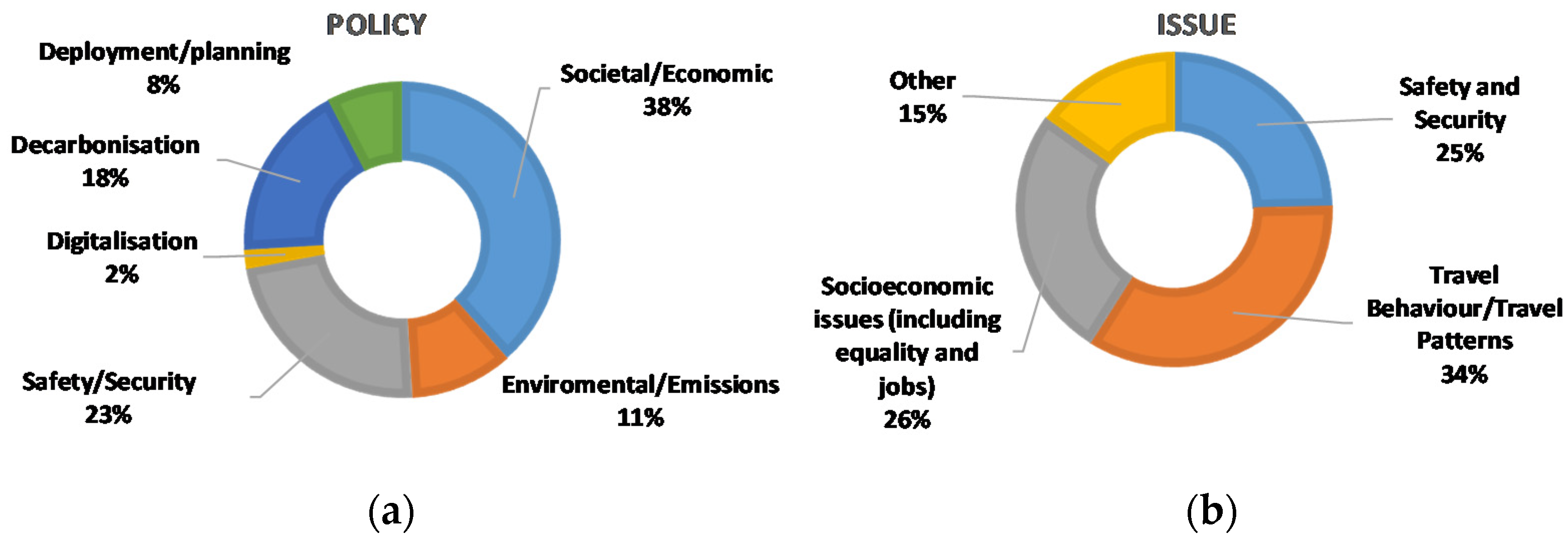
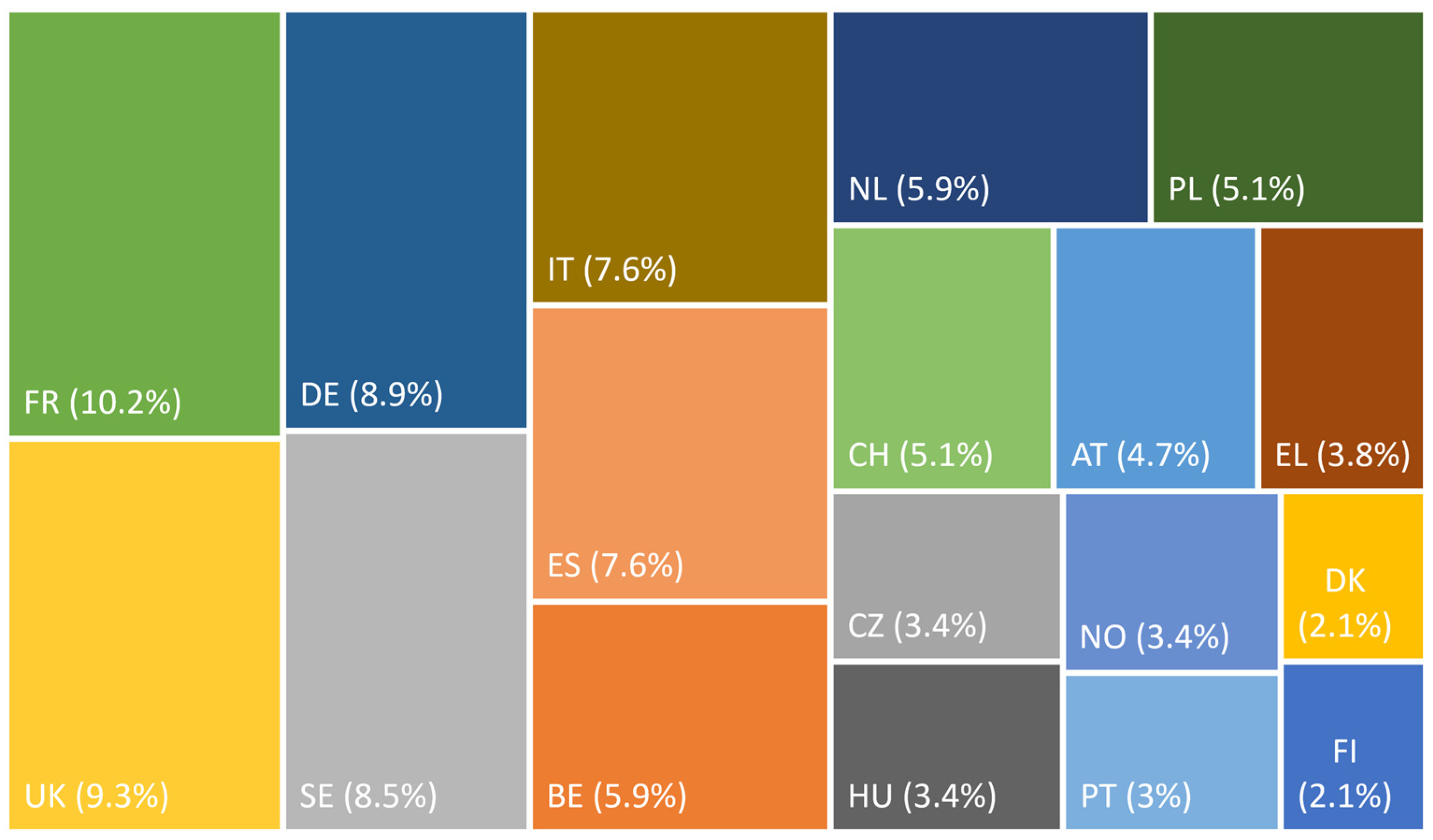

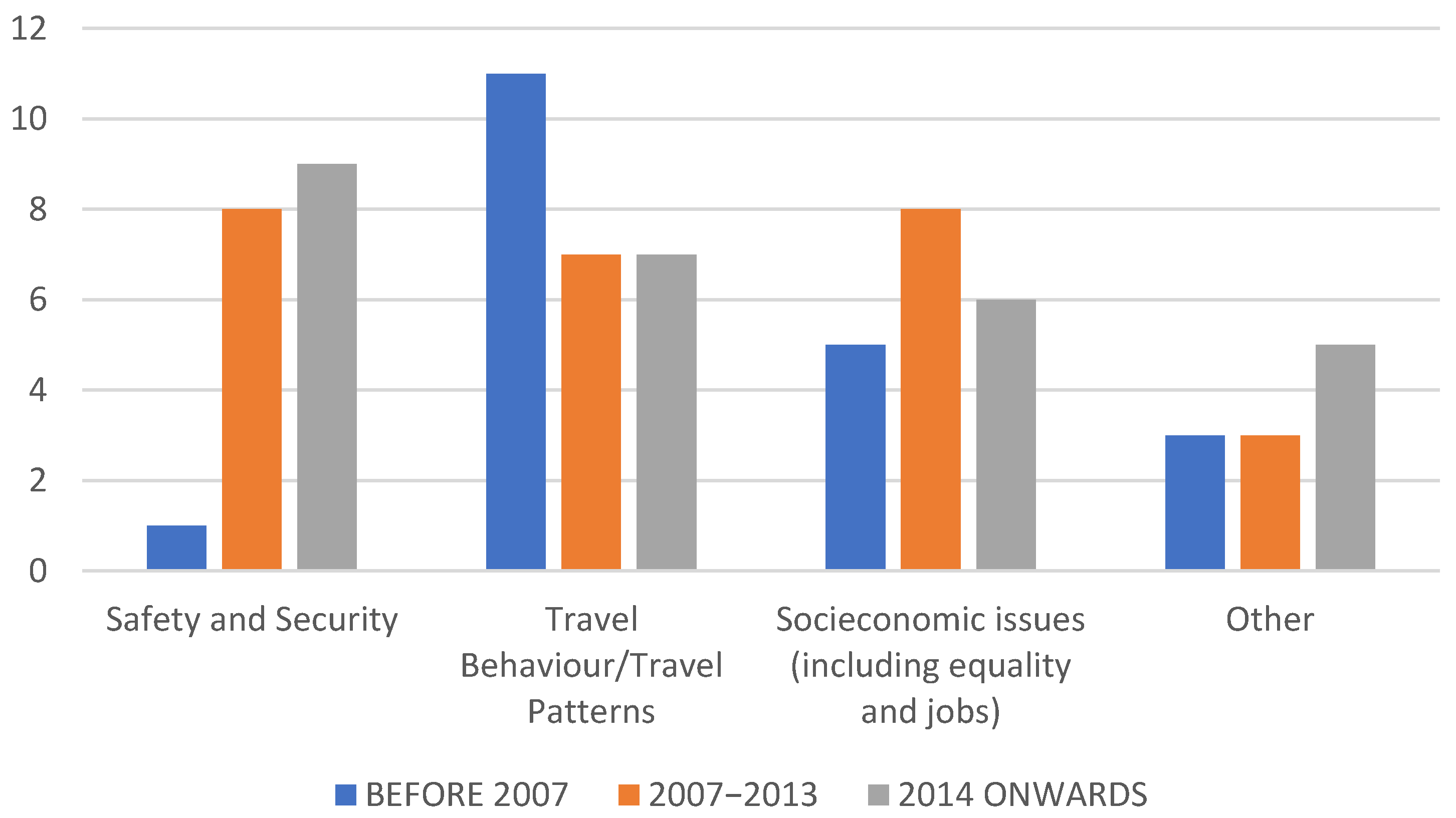
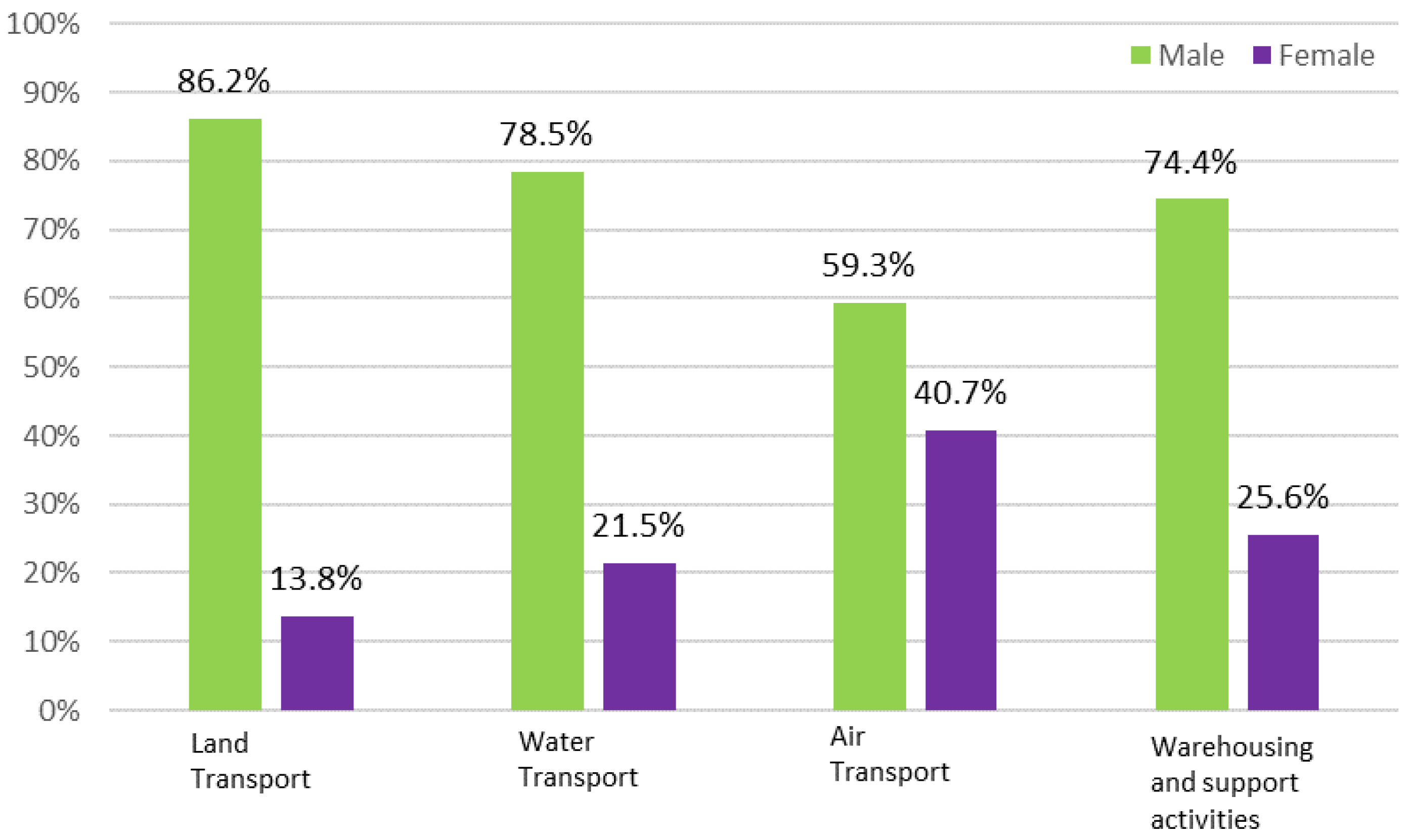

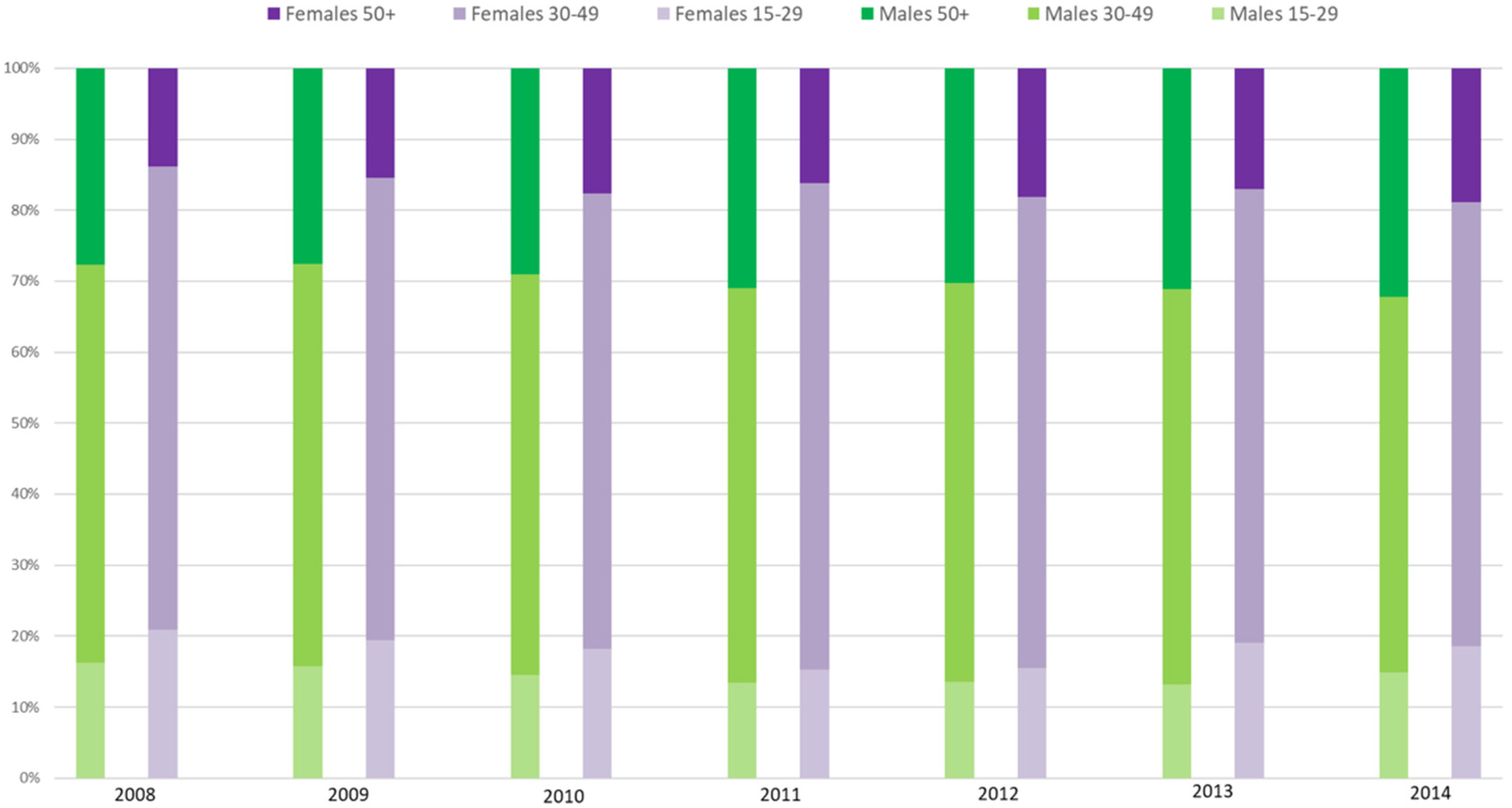
| Transport Economic Activities | |
|---|---|
| C29 | Manufacture of motor vehicles, trailers, and semi-trailers |
| C30 | Manufacture of other transport equipment |
| G45 | Wholesale and retail trade and repair of motor vehicles and motorcycles |
| H49 | Land transport and transport via pipelines |
| H50 | Water transport |
| H51 | Air transport |
| H52 | Warehousing and support activities for transportation |
| H53 | Postal and courier activities 1 |
Publisher’s Note: MDPI stays neutral with regard to jurisdictional claims in published maps and institutional affiliations. |
© 2021 by the authors. Licensee MDPI, Basel, Switzerland. This article is an open access article distributed under the terms and conditions of the Creative Commons Attribution (CC BY) license (https://creativecommons.org/licenses/by/4.0/).
Share and Cite
Hortelano, A.O.; Grosso, M.; Haq, G.; Tsakalidis, A. Women in Transport Research and Innovation: A European Perspective. Sustainability 2021, 13, 6796. https://doi.org/10.3390/su13126796
Hortelano AO, Grosso M, Haq G, Tsakalidis A. Women in Transport Research and Innovation: A European Perspective. Sustainability. 2021; 13(12):6796. https://doi.org/10.3390/su13126796
Chicago/Turabian StyleHortelano, Alejandro Ortega, Monica Grosso, Gary Haq, and Anastasios Tsakalidis. 2021. "Women in Transport Research and Innovation: A European Perspective" Sustainability 13, no. 12: 6796. https://doi.org/10.3390/su13126796
APA StyleHortelano, A. O., Grosso, M., Haq, G., & Tsakalidis, A. (2021). Women in Transport Research and Innovation: A European Perspective. Sustainability, 13(12), 6796. https://doi.org/10.3390/su13126796








